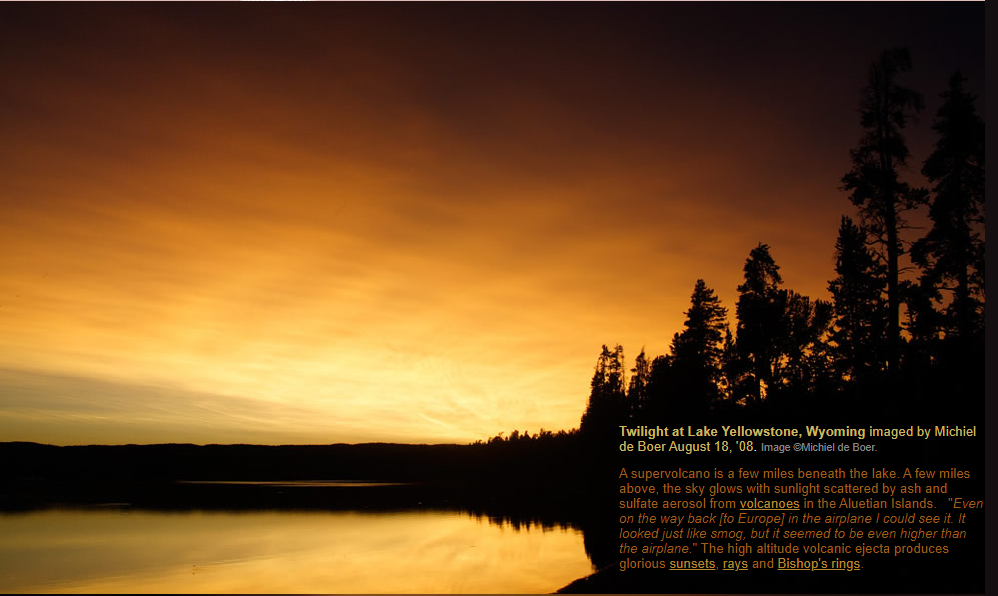Between volcanoes - Yellowstone Skies
Between Volcanoes - Yellowstone Skies: A Spectacular Atmospheric Phenomenon
Yellowstone National Park is renowned for its breathtaking landscapes and geothermal wonders, but its skies hold a mesmerizing secret. Nestled within the park lies a supervolcano, which sits just a few miles beneath the tranquil surface of Lake Yellowstone. While this volcanic activity remains hidden beneath the earth's crust, its impact on the atmosphere above is truly awe-inspiring.
As you gaze up towards the heavens above Yellowstone, you may notice something extraordinary - the sky seems to radiate with vibrant hues, casting a mesmerizing glow over the surrounding landscape. This celestial spectacle is a result of sunlight interacting with ash and sulfate aerosols expelled by volcanoes in the distant Aleutian Islands.
The high-altitude volcanic ejecta, propelled high into the atmosphere by powerful eruptions, scatter sunlight in unique ways, creating a host of atmospheric phenomena. These phenomena include magnificent sunsets that paint the sky with vivid colors, ethereal rays that extend across the horizon, and enchanting Bishop's rings encircling the sun or moon.
While witnessing these breathtaking displays of natural beauty, it's fascinating to note that their influence extends far beyond the immediate vicinity of Yellowstone. Travelers flying back to Europe from the United States have reported observing a smog-like haze lingering in the sky, seemingly higher than their airplanes. This phenomenon serves as a testament to the far-reaching impact of volcanic aerosols on our atmosphere.
The scattering of sunlight by volcanic ash and sulfate aerosols produces an array of optical effects that captivate both scientists and nature enthusiasts alike. One such effect is known as Rayleigh scattering, where shorter wavelengths of light, such as blue and violet, are scattered more prominently than longer wavelengths, giving rise to the stunning blue skies we often associate with clear weather.
However, when volcanic aerosols are present in the atmosphere, they scatter sunlight in a different manner. The ash and sulfate particles are larger than the molecules responsible for Rayleigh scattering, causing a phenomenon called Mie scattering. This scattering process scatters sunlight more evenly across the spectrum, resulting in vibrant and colorful sunsets as the scattered light interacts with the atmosphere.
In addition to the mesmerizing sunsets, volcanic aerosols can also create captivating optical phenomena such as rays and Bishop's rings. Rays, also known as crepuscular rays or sunbeams, appear as beams of light radiating from the position of the sun, filtering through gaps in clouds or other atmospheric obstructions. These rays can stretch across the sky, creating a breathtaking visual display.
Bishop's rings, on the other hand, manifest as a series of concentric circles surrounding the sun or moon. These rings are formed when sunlight or moonlight is diffracted by tiny water droplets or ice crystals in the atmosphere. The presence of volcanic aerosols can enhance the visibility and intensity of these rings, making them even more striking to behold.
In conclusion, the skies above Yellowstone National Park hold a hidden treasure for those who take the time to look up and marvel at the wonders of our atmosphere. The interplay between the supervolcano lurking beneath Lake Yellowstone and the distant volcanoes in the Aleutian Islands creates a mesmerizing display of atmospheric optics. From vibrant sunsets to ethereal rays and enchanting Bishop's rings, these phenomena serve as a reminder of the profound influence that volcanic activity can have on our skies. So, next time you find yourself in Yellowstone, remember to cast your gaze towards the heavens and witness the magic unfolding above.

Twilight at Lake Yellowstone, Wyoming imaged by Michiel de Boer August 18, '08. Image ©Michiel de Boer.
A supervolcano is a few miles beneath the lake. A few miles above, the sky glows with sunlight scattered by ash and sulfate aerosol from volcanoes in the Aluetian Islands. "Even on the way back .to Europe. in the airplane I could see it. It looked just like smog, but it seemed to be even higher than the airplane." The high altitude volcanic ejecta produces glorious sunsets, rays and Bishop's rings.
Note: this article has been automatically converted from the old site and may not appear as intended. You can find the original article here.
Reference Atmospheric Optics
If you use any of the definitions, information, or data presented on Atmospheric Optics, please copy the link or reference below to properly credit us as the reference source. Thank you!
-
<a href="https://atoptics.co.uk/blog/between-volcanoes-yellowstone-skies/">Between volcanoes - Yellowstone Skies</a>
-
"Between volcanoes - Yellowstone Skies". Atmospheric Optics. Accessed on December 26, 2024. https://atoptics.co.uk/blog/between-volcanoes-yellowstone-skies/.
-
"Between volcanoes - Yellowstone Skies". Atmospheric Optics, https://atoptics.co.uk/blog/between-volcanoes-yellowstone-skies/. Accessed 26 December, 2024
-
Between volcanoes - Yellowstone Skies. Atmospheric Optics. Retrieved from https://atoptics.co.uk/blog/between-volcanoes-yellowstone-skies/.